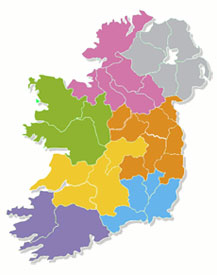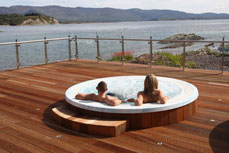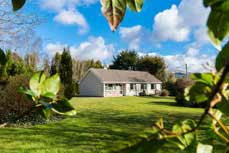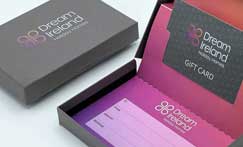SELF CATERING ACCOMMODATION GUIDE TO CASTLEGREGORY, CO. KERRY, IRELAND
About Castlegregory
Castlegregory is situated on the north side of the Dingle Peninsula, halfway between Tralee and Dingle. The Maharees Peninsula, to the north of the village, is acclaimed for its sandy beaches and clean water. Castlegregory village, the Maharees, and the surrounding areas offer tranquility and beauty that are far removed from the quickening pace of urban life.
Activities in Castlegregory and the Maharees
During the summer months, there is a wide variety of entertainment in Castlegregory, from currach racing to a week-long carnival in July. Castlegregory Pattern Day is celebrated on 15 August, when the tradition is to eat locally-made mutton pies and wash them down with plenty of Guinness. On summer evenings, traditional music can be heard at several pubs in the village. There are a number of restaurants, cafes and pubs in Castlegregory and the Maharees, offering everything from take-away to fine dining, with local seafood a specialty. The area is abundant with golden sandy beaches!
Beaches in Castlegregory and the Maharees
The longest beach in Ireland stretches from the Maharees westwards through Castlegregory to Cloghane village– showcasing 12 miles of beautiful beach. There is also a Blue Flag beach in the Maharees. All of the beaches are sandy, and many are suitable for surfing and other water sports. The unspoiled sea water and vast sandy beaches of the entire area is what keeps people flocking to Castlegregory year after year.
Horse Riding and Pony Trekking on the Dingle Peninsula
In the Maharees area, there is pony trekking along the beaches.
-
Goodwin's family run school on the Maharees. Phone (066) 713 9106 or ask locally.
-
El Rancho riding stables near Tralee. Phone (066) 712 1840.
-
Eagle Lodge Equestrian Centre, (066) 713 7266.
-
Pony Trekking from Castlegregory Village, ask in the Post Office/ Tourist Office for details. Equipment and instruction are available locally.
Golf in Castlegregory
For golfing enthusiasts, Castlegregory Golf and Fishing Club is located in Stradbally, just a few miles from Castlegregory village. Castlegregory Golf Links situated between the scenic Lough Gill and Brandon Bay offers visitors magnificent views of Mount Brandon from this scenic nine-hole course.
Castlegregory - The Home of Water Sports
Jamie Knox Water Sports Centre in Castlegregory offers something for everyone from the beginner to the professional and everything in between. Take your pick from a host of water activities including surfing, wind surfing or kite surfing. All courses are run by qualified and experienced instructors and over seen by ex-professional wind surfer, Jamie Knox.
Fishing In Castlegregory and The Dingle Peninsula
Game, Shore, and Deep Sea angling are all available in Castlegregory and its surrounding area. The 3 lakes of Lough Slat, Lough Doon and Lough Caum, attracts local and visiting anglers alike, and possess a sense of calm which will stay with you long after your day's fishing.
For those interested in game angling, Lough Caum in Glannteenassig Forest near Castlegregory is a truly beautiful place with a haunting sense of calm. The lake itself boasts a large stock of wild brown trout and is also stocked with rainbow trout. Permits are required and boats and permits are available locally. The Owenmore River is also an ideal spot for game fishing.
For the shore angler, the ideal spot is never difficult to locate with miles of famous beaches with roaring surfs for the sportsman after bass or painted rays, quiet beaches and estuaries offer skate, flounder and plaice; while Pollock, wrasse and conger eels can also be found in the numerous deep water rock pools.
Places of Interest near Castlegregory:
Glanteenassig
Glanteenassig (the valleys of the waterfall)– has an abundant forestry development and is one of the most beautiful places on the peninsula. On a fine day views of Glanteenassig can resemble the landscapes of Killarney and the beauty of County Wicklow more than that of the rest of the peninsula. Glanteenassig is also well known as a peaceful forest trail through woodland with the spectacular back drop of the Slieve Mish mountains, crystal lakes and sheltered valleys.
Lough Gill
Lough Gill is just a quarter-mile from Castlegregory village and is somewhat of a nature reserve as a major breeding ground for the rare Natterjack Toad. On a fine summer night, the natter jack can be heard for miles. Lough Gill is also one of the few places where Bewick, Mute and Whooper swans can all be seen.
Ventry
Ventry is a small village four miles west of Dingle. It is unusual in that it has two centres of commerce, both comprised of a pub and a shop. One has the Catholic church, and the other, in true balance, has the primary school. The whole Ventry area is linked by the arc of Ventry Harbour, with one of the most alluring and safe beaches on the west coast of Ireland.
Dingle
DINGLE (An Daingean) is the most westerly town in Europe and is often referred to as “the next parish to America”. Piled high with majestic mountains and bordered with an abundance of quiet unpolluted beaches this colourful tourist town is a haven for walkers, golfers, surfers, sailors, sightseers and deep sea fishermen. The town also offers a wide selection of bars and restaurants which make full use of the fresh seafood that is landed at the harbour every day. This is a Gaeltacht area with something for all walks of life!
Annascaul
Annascaul and Inch lie in the Southern foothills of the Slieve Mish Mountains. This range forms the backbone of the Dingle Peninsula. Mountains and beaches are an exciting combination offering amazing possibilities for recreation. Walking in the area ranges from sea level to the mountains around Annascaul lake and river. Thomas Crean the Antarctic Explorer, is Annascauls most famous export and his pub "The South Pole Inn" still stands in the centre of the village with memorabilia from all 3 expeditions - Discovery, Terra Nova and Imperial Trans-Antarctic (Endurance Expedition).
Camp
Camp is a small, village in a beautiful scenic area near the foot of the Slieve Mish Mountains and looks out over the sea, Brandon mountains, Tralee Bay, and Kerry Head. Camp is centrally located to the Dingle Peninsula on either side, with close proximity to a number of good, safe, sandy beaches. Tralee Town and commercial centre is only 10 miles to the east and the tourist town of Dingle Town 20 miles to the west.
Fenit Harbour
Fenit Harbour is a small fishing village about 10KM West of Tralee Town. Fenit Harbour and it's 136 berth marina are the main source of business for this coastal village. Tralee Bay Sailing Club in Fenit, Co. Kerry was founded in 1956 by a group of local enthusiasts. From rudimentary beginnings the Club has grown and now boasts a vibrant and expanding membership together with a clubhouse and a sailing school.
Blennerville
Blennerville Village located just outside Tralee where the capital town meets the Dingle Peninsula is a must for any visitor to the Kingdom. Blennerville Windmill and Steam Train are an enjoyable and educational outing for the whole family.
Tralee
Tralee, the Capital of Co. Kerry is world famous for its annual Rose Of Tralee Festival, which celebrates culture in Irish communities throughout the world. Tralee Town plays host to the group of finalists who's life long desire is to bring the coveted Rose of Tralee title back to their centre.
The town of Tralee is an excellent location for all outdoor activities, sports, restaurants and places of interest including the folk theatre at Siamsa Tire, the Geraldine Centre and the Aqua Dome which are all high on the list of family activities that can be enjoyed by all ages.
Places to Eat and Restaurants in Castlegregory:
-
-
Boland's Bar, Castlegregory
-
Bowler's Bar, Castlegregory
-
Ferriter's Loft Bar
Full food menu all year.Weekend music all year. -
Jimmy Fitzgerald's, Castlegregory, 066-7139417.
-
Maurice Fitzgerald, Castlegregory, 066-7139133.
-
Michael Fitzgerald, Castlegregory, 066-7139225.
-
Ned Natterjacks , Castlegregory, 066-7139491.
Full food menu during season. Regular traditional sessions. -
O'Connor's Green Room Bar , Maharees, 066-7139153.
Sandwiches and home baking during season.Impromptu music sessions. -
O'Riordan's Restaurant, Tralee Road, 066-7139379.
Open from 11 AM to 9 PM seasonally for lunch and dinner. -
Spillane's Bar & Restaurant, Maharees, 066-7139125.
Food served from Easter to October. -
Tomásín's Bar & Restaurant, Stradbally, 066-7139179.
Full food menu during season.
The Dingle Peninsula and Castlegregory has it all, with activities to suit everyone's tastes and at any time of the year.
History of Castlegregory
Castlegregory is traditionally what you would call a close knit, yet welcoming Irish village.
The castle from which the name was derived was built in the mid 16th Century by Gregory Hoare, but is no longer standing. There has long been a tradition that the name derived from the late 6th Century pope, Saint Gregory the Great, known as Gregory Goldenmouth and claimed to be of the Corca Dhuibhne people. However, Pope Gregory was probably confused with another saint; Saint Gregory who was Irish and affiliated with the Iveragh Peninsula; Gregory Hoare is the much more likely origin of the place name.
There is a story associated with the castle which is reminiscent of the relationship between the Montagues and Capulet's in Shakespeare's "Romeo and Juliet". Gregory Hoare had a dispute with a neighbour called Moore. In the face this and in a bid to rebel against parental authority, Hugh, Gregory's son, married Moore's daughter Ellen in 1566. As they returned to the castle after the wedding, Gregory stood at the gate to greet his son but a verbal altercation persued and as his son pushed past him the ill-fated Gregory fell to his death.
In 1580 part of Lord Grey of Wilton's army – including, it is said, Edmund Spenser, Walter Raleigh and Edward Denny – stayed at the castle on their way to besiege Dún an Óir. Furious at her husband for harbouring the enemy, Hoare's wife, Ellen, went to the cellar and ran off all the wine from the barrels there. Hugh Hoare was outraged and attacked his wife stabbing her to death. Next morning he was summoned to appear before his overlords to answer a charge of murder, but he fell to his death as he passed the very spot where his father had died 14 years earlier.
A later marriage, of "Black" Hugh's daughter, the ownership of the castle transferred to Walter Hussey of Dingle. He supported the Knight of Kerry in the Cromwellian wars and was pursued by Wilmot's forces from Castlegregory to Minard across the mountains. He died in the destruction of Minard Castle and the Husseys reign in the castle ended. The castle – "slighted" by the English army – and the estate at Castlegregory were settled first on a Cromwellian soldier, then passed to a Derry man who settled locally, and was then bought by the first Lord Ventry in whose family they remained until 1913.
There is a particular large gallán – about 14 feet above the ground – at Candiha, standing near the road amidst vegetables. Kilshannig, out in the Maharees, boasts a much later development of the standing stone – a cross-slab of the 7th Century with an interestingly designed cross. In common with slabs at Kilfountain and Knockane, the Kilshannig cross includes a representation and chi-rho – the Greek initials for Christ – and in this case it is a cryptically formalised loop out of the top of a Latin cross. There is a pagan-derived divergent spiral at the base of the cross. The church here may date in part to the 12th Century but it is mostly a 15th-16th Century reconstruction.
For those interested in the early Christian settlements, it is especially worthwhile to try to persuade someone to take them over to Illauntannig – Oileán tSeanaig. The best thing to do is simply to enquire locally. The early settlement of Seanach is one of the finest of its kind. The enclosing wall, or cashel, is exceptionally strong – about 18 feet thick – though part of it has fallen to the erosion of the sea. In the larger of the two ruined oratories there is an altar and the window survives; there are clocháin, from one of which a sou-terrain runs to a chamber in the enclosure wall. There are cross-slabs; and particularly prominent features are three quartz-covered leachts, rectangular burial platforms. By the shore, a hundred yards from the cashel, is a bullán with an incised cross. A two-storey farmhouse on the island was occupied until the 1950s; and it is known locally as Learie's Island after the people who lived there.





